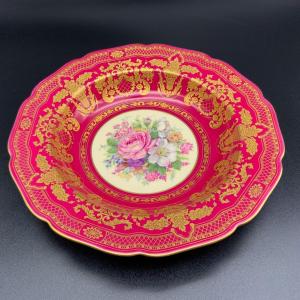Tianqi / Chongzhen, ca. 1630-1645.
The small sized molded deep dish with foliated rim in lotus flower form, the center decorated with an old yin and yang (taiji) design in concentric circles surrounded by six panels with juxtaposed depictions of wisteria and lotus painted in underglaze blue and copper-red, alternated by diaper patterns of a key fret lei wan or swastika (Buddhist motif, in China it symbolized good luck and eternal abundance) motif, petals and lappets.
The bottom with three lingzhi fungus painted in underglaze blue on the border (representing a wish for a long life) as well as an underglaze blue circle in the center, some kiln sand and grit stuck to the footrim.
This dish, of relatively small size, was used for the Japanese tea ceremony meal called Kaiseki.
Ref:
For similar dishes see:
-Christie’s London, The Peony Pavilion Collection: Chinese Tea Ceramics for Japan (c. 1580-1650), Monday 12 June 1989, lot 348.
-S. Marchant and Son, Exhibition of Chinese Blue and White - Wan Li to K’ang Hsi, 1985, no 45.
Dimensions:
Diameter 14.3 cm, height 4 cm.
Condition:
Overall good condition - some fritting and nibbles (Mushikui) to the rim and a chip on the inside of the footrim resulting in a faint hairline showing on both sides.
Underglaze copper-red:
Firing underglaze copper-red ceramics is notoriously difficult because it requires precise heat control, atmospheric conditions and air circulation within the kiln as well as careful preparation of the pigment itself. There was no guarantee of the final colour of the vessels being fired, therefore the success rates of underglaze copper-red ceramics was typically low.
Symbolism:
The central medallion is based on the neo-Confucian diagram of the ‘Supreme Ultimate’ by Chou Tun-i, which in turn was based on an earlier Taoist diagram of the Tang dynasty.
Worldwide registered and insured shipping.
Take a look at our other listings for more Asian art, antiques, design, etc.
Code: A00529






























 Le Magazine de PROANTIC
Le Magazine de PROANTIC TRÉSORS Magazine
TRÉSORS Magazine Rivista Artiquariato
Rivista Artiquariato
